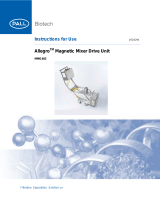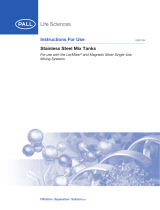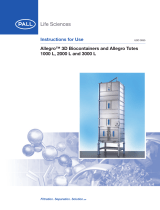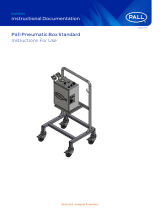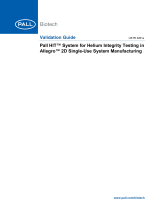Page is loading ...

www.pall.com/biotech
CONFIDENTIAL: This document is the confidential work product of Pall Corporation and no portion of this
document may be copied, published, performed, or redistributed without the express written authority of
a Pall corporate officer. This document is furnished for use by the assigned recipient only. This material is
confidential and is not to be divulged to others without specific written permission from Pall Corporation.
Instructions for Use USD 3293
AllegroTM LevMiver® Drive Unit
LMG403

2
Contents
1 Warnings .................................................................................................................................................. 4
1.1 Hazard Icons................................................................................................................................ 4
1.2 Safety Messages ......................................................................................................................... 5
2 System Overview ...................................................................................................................................... 7
2.1 Introduction .................................................................................................................................. 7
2.2 LevMixer Single Use (SUS) Mixing System ................................................................................ 8
2.3 Optional Compatible Equipment .................................................................................................. 8
2.4 Mixing System Components and Accessories ............................................................................ 8
3 Installing the LevMiver System Hardware .............................................................................................. 11
3.1 Unpacking the LevMixer Drive................................................................................................... 11
3.2 Interface with O-Ring ................................................................................................................. 11
3.3 Dolly – Tank Assembly .............................................................................................................. 12
3.4 Changing Dolly Configuration between Centre and Off – Centre Impeller Port ........................ 13
3.5 Allegro Mixing Biocontainer Installation ..................................................................................... 14
3.6 Drive Unit Configuration ............................................................................................................ 18
3.7 Drive Configuration Set-Up ........................................................................................................ 20
3.8 Docking of the Drive Unit to the Tank and Biocontainer ........................................................... 23
3.9 Docking of Drive Unit to Round Plastic Tank ............................................................................ 25
3.10 Removing Drive Unit from Tank ................................................................................................ 26
4 HMI Interaction ....................................................................................................................................... 27
4.1 User Interface Overview ............................................................................................................ 27
4.2 Charging the Superconductors .................................................................................................. 29
4.3 Charging Procedure .................................................................................................................. 32
5 Operator Control Interface Guide ........................................................................................................... 34
5.1 Navigating the LevMixer Control Screen ................................................................................... 34
5.2 User Access Levels ................................................................................................................... 35
5.3 Power Up ................................................................................................................................... 37
5.4 Operating the LevMixer System ................................................................................................ 39
5.5 Automatic Mode ......................................................................................................................... 40
5.5.1 Loading Recipe .......................................................................................................................... 41
5.5.2 Running a Recipe ...................................................................................................................... 41
5.5.3 Aborting a Recipe ...................................................................................................................... 42
5.5.4 Pausing and Resuming a Recipe .............................................................................................. 42
5.5.5 Editing a Recipe ........................................................................................................................ 42
5.6 Manual Mode ............................................................................................................................. 43
5.6.1 Setting up a Manual Operation .................................................................................................. 44

www.pall.com/biotech
3
5.6.2 Starting a Manual Operation ...................................................................................................... 45
5.6.3 Stopping a Manual Mode Operation (Permanent Run) ............................................................. 45
5.6.4 Stopping a Manual Mode Operation (Time Run)....................................................................... 45
5.6.5 Pausing and Resuming in Manual Mode ................................................................................... 45
5.7 Remote Mode ............................................................................................................................ 46
5.8 Locked Mode ............................................................................................................................. 47
5.8.1 Locked Mode Operation ............................................................................................................ 47
5.8.2 Local Operator Involvement ...................................................................................................... 48
5.9 Alarms ........................................................................................................................................ 49
5.10 Auxiliary Functions .................................................................................................................... 52
5.11 Notifications Displayed after Mixing Run ................................................................................... 55
5.12 Initial Settings ............................................................................................................................ 55
6 Alarms and Trouble Shooting ................................................................................................................. 56
6.1 General Alarm Information ........................................................................................................ 56
6.2 List of Alarms ............................................................................................................................. 56
6.3 Troubleshooting ......................................................................................................................... 57
7 Cleaning and Maintenance ..................................................................................................................... 58
7.1 General Warnings ...................................................................................................................... 58
7.2 Hardware Cleaning .................................................................................................................... 58
7.3 Maintenance Procedures ........................................................................................................... 59
7.3.1 Sensor Ring Replacement ......................................................................................................... 59
7.3.2 Power Cord Replacement ......................................................................................................... 60
7.3.3 Micro SD Card Replacement ..................................................................................................... 61
7.3.4 Fuse Replacement .................................................................................................................... 62
7.3.5 LED Bulb Replacement ............................................................................................................. 63
7.3.6 Air Filter Inspection .................................................................................................................... 64
7.3.7 Speed Calibration Verification ................................................................................................... 64
7.4 Hardware Preventative Maintenance ........................................................................................ 66
7.5 Service ....................................................................................................................................... 66
7.5.1 Warranty .................................................................................................................................... 66
7.5.2 Pall Service ................................................................................................................................ 66
7.6 End of Life Disposal ................................................................................................................... 66
8 Detailed Specification ............................................................................................................................. 67
8.1 Hardware Technical Specification Summary ............................................................................. 67
8.2 Electrical Specifications ............................................................................................................. 69
9 Appendix A: Declaration of CE Conformity ............................................................................................ 72

4
1 Warnings
1.1 Hazard Icons
WEEE:
Waste of Electrical and Electronic Equipment
Electrical Safety (high voltage)
Caution (general warning)
Strong magnetic field (may affect pacemakers)
Main power switch
CE certified
Earth to Ground.
Information / Notes
Do not operate if you have a Pacemaker.
Stay 33 cm (13 in.) away until consulting with a physician.
Prohibited

www.pall.com/biotech
5
1.2 Safety Messages
1. Read and follow all instructions in this manual carefully, and retain this manual for future reference
2. Do not use this instrument in any manner inconsistent with these operating instructions, or under any
conditions that exceed the environmental specifications stated.
3. Be sure the power supplied to this instrument matches the specifications indicated on the control box.
4. This instrument should not be lifted. If it is required to be moved, the device should be rolled on a flat
surface.
5. If the drive unit is transported or stored in temperatures colder than the operating environment, it is
necessary to wait 1 - 2 hours to equalize the internal temperatures of the drive unit before powering
on.
6. If the impeller rotation is stopped for unplanned reasons (mains fault or alarm), impeller rotation can
only be resumed by intentional operator actions.
7. Prior to servicing the drive unit, always turn the power off using the ‘ON / OFF’ switch on the front
panel of the unit. Unplug, and remove power cord to avoid tangling or breaking.
8. Be sure all power is disconnected before opening, assembling or disassembling the superconductive
drive unit or its control box.
9. For full compliance with CE specifications, be sure the appropriate ground connection is made.
10. For technical assistance contact the sales organization from which you purchased the product, or
Pall directly.
11. Each LevMixer mixing biocontainer contains a magnetic impeller, which is a source of strong
magnetic field within proximity (305 mm /12 in.) of the impeller.
12. Keep the supplied soft magnetic shields on biocontainers, magnetic chargers, and impellers when
not in use.
13. This instrument is not intended to be used with flammable liquids / substances or in hazardous
atmosphere. Use of the LevMixer with flammable liquids /substances could lead to a fire, injury, or
loss of life.
14. The machine is intended for indoor use in atmosphere not containing corrosive substances.
15. The frame and body of the machine consists of 304 stainless steel and may be cleaned with water
and isopropyl alcohol.

6
Do not:
• Open the machine or control box while the drive unit is plugged in.
• Submerge the drive unit in water. The unit outer surfaces may be cleaned and
sanitized by wiping with a mild detergent solution.
• Position the machine in the way that the power switch on face panel is difficult
to operate.
• Obstruct access to outlet where machine is plugged to power line. Keep point
of connection visually and physically easy accessible.
• Cut the ground plug.
Caution.
• Ensure the system is turned off before cleaning the device.
• Disconnect all power before servicing.
• Disconnect all power before servicing.
• Disconnection of the Protective Earth Connector may impair the protection
provided by the system.
• Disconnection of the Protective Earth Connector may impair the protection
provided by the system.
• Mains outlet used to power the equipment must be within 3 meters of the
device and easily accessible.

www.pall.com/biotech
7
2 System Overview
2.1 Introduction
The LevMixer’s mixing technology is based on non-contact magnetic coupling between conventional
permanent magnets in the impeller and superconducting material in the drive unit. Superconducting material
traps the magnetic field generated by the permanent magnets and locks ‘the magnetic field in memory,’ in an
equilibrium position (figure 1).
Figure 1 – Non-contact magnetic coupling between the permanent magnet and superconductor. The
superconducting material traps the magnetic field from the magnet, resulting in stable mechanical coupling
without physical contact.
The trapped magnetic field behaves like mechanical spring; if the magnet is moved up, down or sideways by
outside forces (e.g. gravity or angular torque), it will tend to be pulled back to an equilibrium position. The
peculiar nature of magnet-superconductor interaction ties the two bodies together resulting in a very stable
mechanical coupling with finite equilibrium separation.
The cryogenic temperatures (approx. –200o C) required for the superconducting material are achieved by an
internal cryocooler (sterling cycle refrigerator).

8
2.2 LevMixer Single Use (SUS) Mixing System
The mixing system hardware has three major components:
1. Superconducting drive unit
2. Elevated retaining tank (either on dolly or with integrated legs)
3. Drive port that couples drive unit with biocontainer
In addition to stand alone implementation, the LevMixer (LMG403) can be linked directly to other Pall systems
such as, the Pall MVP SUSs, or Pall single-use tangential flow system (SUTFF) to allow those systems to
control the mixer as part of an automated, integrated solution. This control capability can also be customized
accordingly to link with other distributed control system (DCS) or supervisory control and data acquisition
systems (SCADA).
2.3 Optional Compatible Equipment
Optional additional functionality is provided through one of two automation controllers (advanced and basic)
which facilitate local integration of load cells and probes for use in the mixing applications.
The mixing system can accommodate a variety of standard and custom-designed SUS mixing biocontainers
available from PALL.
The Instructions for Use (IFUs) documents listed below, cover the procedures on integration of the LevMixer
drive unit to variety of containers (shape and size) offered by Pall. For more details on stainless steel tanks
and optional control box, please refer to the following instructions respectively:
• USD 3193: Allegro Cubical LevMixer and Magnetic Mixer Tanks
• USD 3194: Stainless Steel Round Mix Tanks. For use with the LevMixer and Magnetic Mixer
Single-Use Mixing Systems
• USD 3295: Basic / Advanced Control Box for LMG403 and MMG403
2.4 Mixing System Components and Accessories
The image below (figure 2) shows an overview of the Allegro LevMixer System.
Figure 2 - LevMixer Drive Uni (B) with an Accessory Box (A), Stainless steel cubical tank (D) and Plastic
round tank with Dolly (C).

www.pall.com/biotech
9
Figure 3 - Key components of the LevMiver Drive Unit.
Table 1 - Overview of components of LevMixer Drive Unit in figure 3.
Component
Description
B
Levmixer drive unit
B1
Drive unit handle
B2
Drive unto control box
B3
Latch
B4
Drive head
B5
Guide roller
B6
Front wheels
B7
Rear wheels
B8
Sensor ring
B9
Frame

10
Figure 4 - Accessory toolbox (A) in figure 3 contents.
Table 2 - Overview of components within accessory toolbox (figure 4).
Component
Part Number
Description
A1
LT-SVSP365
US power cord
A2
LT-SVSP366
EU power cord
A3
LT-SVSP311
6 magnetic impeller
A4
LT-SVSP313
Soft magnetic shield
A5
LT-SVSP309
Magnetic clamp
A6
LT-SVSP314
7/16 in. (11.11 mm) combination wrench
A7
LT-SVSP305
Centering aligner
A8
LT-SVSP307
6 magnet charger
A9
LT-SVSP312
Clip for 1 in. (25.4 mm) drain valve
A10
LT-SVSP310
4 magnet impeller
A11
LT-SVSP306
4 magnet charger
A12
LT-SVSP485
Bolt kit

www.pall.com/biotech
11
A
B
3 Installing the LevMiver System Hardware
3.1 Unpacking the LevMixer Drive
The LevMixer is shipped in a wooden crate (Error! Reference source not found.) with foam insets to protect
the unit during transport. Make sure to store the tool box in the close vicinity of the drive unit. The crate should
be retained if the drive unit must be shipped for service or repair in the future.
Remove any foam and protective packaging from the drive unit before first use.
Figure 5 – LevMixer transport crate.
3.2 Interface with O-Ring
The Interface provides mechanical interfacing of the drive unit with the impeller inside the biocontainer.
Figure 6 – (A) Drive-biocontainer interface and o-ring. (B) Interface is installed in the railed port of the dolly
(locked by the o-ring).

12
3.3 Dolly – Tank Assembly
If the drive unit is used in combination with a plastic tank on dolly, the following procedure(s) should
be used for installation of the tank on the dolly.
Certain larger tanks (>350 L) are constructed in two parts.
1. Both the Dolly and Tank have holes for drive unit coupling. Insert the drive / biocontainer interface
into this hole from below and apply the o-ring to secure (Error! Reference source not found.). It is
not necessary to remove or replace the interface after installation (i.e. after mixing or between
batches).
Figure 7 - Installation of the drive-biocontainer interface on dolly with o-ring.
2. Position the plastic tank on the dolly. The bottom of the tank has two holes:
• Small hole for the biocontainer
• Larger hole for the drive head.
Line up the larger bottom hole with the drive port on the dolly. The tank hole should locate around the
interface.

www.pall.com/biotech
13
3. Tanks up to and including 350 L use a centrally located impeller and therefore use the central port
dolly configuration. 500 L tanks use SUS with an off-center impeller and therefore use the off-center
port dolly configuration. See chapter 3.4 for changing the dolly port configuration.
3.4 Changing Dolly Configuration between Centre and Off – Centre Impeller Port
Determine which port configuration is required. Central port (tanks sizes 30 – 350 L tanks) or off-centre port
(500 L tanks). Each rail of the dual port has an adjuster attached to the rail with two screws. The right
adjuster is marked with two dots and the left adjuster is marked with one dot. The right and left rails of the
port are also marked with two and one dot respectively (Figure 8). Right adjuster should always be used with
the right rail and the left adjuster with the left rail.
Figure 8 - Rail port orientation – Showing left side vs. right.
To set the rails for the central port position set the right and left adjusters so that the side with word
“CENTER” is visible on both (Figure 9). Ensure that the two dot marks on the right adjuster are located next
to the two dot marks on the rail and single dot mark of the left adjuster is located next to the single dot mark
on the left rail. Secure the adjusters with the screws provided.
Figure 9 - Rail adjustments for central position (left and right side).

14
To set the rails for the off centre port position set the right and left adjusters so that the side with words
“OFF-CENTER” is visible on both (Figure 10). Ensure that the two dot marks on the right adjuster are located
next to the two dot marks on the rail and single dot mark of the left adjuster is located next to the single dot
mark on the left rail. Secure the adjusters with the screws provided.
Figure 10 - Rail adjustments for off-centre position (left and right).
3.5 Allegro Mixing Biocontainer Installation
The below procedure describes the basics of installing an Allegro mixing biocontainer in a tank. For more
detailed instructions, please refer to the instructions delivered with the stainless-steel tanks.
1. Locate the magnetic clamp and centering aligner (Figure 10). These parts are required for proper
Allegro mixing biocontainer installation and alignment. Inspect the centering aligner for damage; if the
center hole is deformed, torn or not concentric, discard and replace with an undamaged centering
aligner. Assemble the clamp and aligner (Figure 11).
Figure 11 - Centering aligner (left) and magnetic clamp (right).

www.pall.com/biotech
15
Figure 12 - Magnetic clamp assembled with centering aligner.
2. Verify the correct article code and expiration date on the mixing biocontainer. Remove the outer and
inner packaging biocontainer by tearing open at the easy tear notch (Figure 12). Retain the label from
the inner packaging according to the Quality policies of your organization.
Do not use scissors or other cutting implements
Figure 13 - Opening packaging biocontainers via the easy tear notch.

16
3. Visually inspect the Allegro mixing biocontainer for shipping damage or imperfections; cuts, tears or
punctures; film cracks that are externally rough / sharp to the touch) impeller detached from impeller
seat / post; kinked tubing that cannot be unkinked; damaged, missing or detached subcomponents. If
any such imperfections are discovered, contact Pall or the user organization’s quality group for advice
on whether the Allegro mixing biocontainer should be used.
White creases that are not sharp to the touch are typically not a cause for concern.
4. A blue shipping disc is magnetically attached to the outside of the Allegro mixing biocontainer, over
the impeller seat. Reverse the Allegro mixing biocontainer to have access to the magnetic impeller
with the blue disc. Next, remove the blue shipping disc. Retain this item; this will be used to secure
the impeller during subsequent Allegro mixing biocontainer disposal.
Figure 14 – Removing blue shipping disc from Allegro mixing biocontainer.
5. Assemble the centering aligner and magnetic clamp on the impeller on the Allegro mixing biocontainer.
Figure 15 - Assembly of Allegro mixing biocontainer with magnetic clamp / aligner assembly

www.pall.com/biotech
17
6. Place the Allegro mixing biocontainer in the tank by aligning the magnetic clamp with the large port on
the bottom
Figure 16 - Biocontainer-tank assembly with round plastic tank.
Do not:
• Exceed recommended biocontainer capacity.
• Alter the tube and / or impeller configuration.
7. For round plastic tanks, gently pull the bottom drain tube through the drain port opening. For other
tanks, please refer to the specific instructions delivered with the tank.
8. Before filling the biocontainer, ensure that the bottom drain tube is clamped. If the biocontainer
contains an EZ-Drain♦, ensure the drain is fully closed and clamp the drain in place using the
provided plastic drain clip.
As the biocontainer starts to fill, gently pull the bottom surface of the biocontainer to remove any wrinkles,
especially near the impeller.

18
3.6 Drive Unit Configuration
The Drive Unit can be used in one of two configurations:
1. Standard
2. Extended.
The configurations can be switched following the procedure.
Each configuration allows connection of the unit to different tank sizes using a universal latch. Positions 1 and
2 are in standard configuration, positions 3 and 4 are in extended configuration. 4 show the different latch
positions for each tank size. Marks on the frame at each latch location show proper positioning of the latch.
Figure 17 - Different latch positions for drive unit.

www.pall.com/biotech
19
Table 3 - Latch positions/configuration cubical tanks.
Cubical Tank Latch Positions
Volume
Position
Stamp on Frame
Configuration
50 L
2
(23) 15
Standard
100 L
2
(23) 15
Standard
200 L
2
(23) 15
Standard
400 L
2
(23) 15
Standard
650 L
4
(23) 15
Extended
1000 L
4
(23) 15
Extended
1500 L
4
(23) 15
Extended
2000 L
4
(23) 15
Extended
3000 L
4
(23) 15
Extended
Table 4 - Latch positions / configuration round tanks.
Round Tank Latch Positions
Volume
Position
Stamp on Frame
Configuration
30 L
2
(23) 15
Standard
50 L
2
(23) 15
Standard
100 L
2
(23) 15
Standard
200 L
2
(23) 15
Standard
350 L
2
(23) 15
Standard
500 L
2
(23) 15
Standard
1000 L
2
(23) 15
Standard
2000 L
3
(20)
Extended
2500 L
3
(20)
Extended

20
3.7 Drive Configuration Set-Up
To change frame configuration, follow steps below
1. Release cables from the two cable clips on the angled cross bar on the frame.
2. At the four frame connection points loosen and remove the two nuts on the side connections and the
two nuts on the top connections.
3. Pull out the carriage screws at the four frame connection points and remove the two bushings
installed in the side tabs. Hold the frame at the heavier control box side to prevent it from tipping.
4. Move the frame to align it with the other set of connection points corresponding to the new frame
configuration.
Figure 18 – Collapsed configuration (left) and extended configuration (right).
5. Insert the four carriage screws into new four frame connection points. The two side bolts should go
through bushings. In the extended position, the bushings are flipped to internal side on frame ends
compare with collapsed position of frame.
6. Secure the frame with the four nuts at the connection points. Tighten the nuts. Make sure the square
portion of screw heads are fitted into the square holes in frame.
7. Secure front bracket with the LT-SVSP485 Bolt Kit through side holes on both sides.
8. Adjust and clip the cables to the frame as per frame configuration displayed in
/
